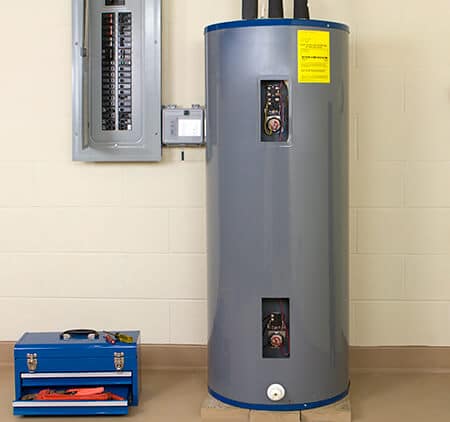Tips for Properly Flushing Your Water Heater

If you’re like most homeowners, you don’t give much thought to the hot water that comes out of your faucet. However, your water heater works hard to ensure that you have hot water when you request it. To ensure that your water heater continues to work great, it’s imperative that you flush it out at least once per year.
Why Does Your Water Heater Need to Be Flushed?
The water that flows through your water heater will naturally have sediment in it. Over time, this sediment will accumulate at the bottom of your water heater tank. Regular flushing is a great way to flush out this sediment before it starts to calcify. If you wait too long, the calcified sediment will be near impossible to remove and drastically reduce the lifespan of your water heater.
A Note on Gas vs. Electric Water Heaters
There are two main types of water heaters that you may have in your home. These are gas-powered and electric-powered water heaters. While both systems are flushed in the same way, the main difference is in how you turn them off to perform the flushing.
With an electric water heater, you’ll simply need to turn the power off to it. You’ll do this by locating its circuit breaker in your electrical panel box. With a gas water heater, you’ll need to shut the gas off to it. You’ll find the gas valve near the bottom of the tank. You’ll also want to set your tank’s thermostat to its OFF position.
Turn Off the Cold Water Supply
Located at the very top of your water heater will be two sets of piping. One is the cold water supply that brings cold water into your water heater tank. The other is a hot water line that pumps hot water out of the water heater and delivers it to the various faucets and appliances throughout your home.
You’ll want to turn off the cold water supply valve. You can typically tell the cold water pipe versus the hot water pipe by looking at the valve color. Most cold water supplies will have a blue valve as compared to a red valve for the hot water pipe.
Turn on Your Hot Water
Next, you’ll want to turn on the hot water to the closest faucet or appliance in your home. This will help to remove any excess hot water in the lines. Make sure that you leave the faucet or appliance on for the duration of your cleaning process. This will help to prevent a vacuum effect from forming in your water lines during the draining process.
Hook a Hose Up to the Drainage Spigot
At the bottom of your water heater will be a spigot. You’ll want to screw on a hose in order to direct the water coming out of the tank. Make sure that the other end of the hose either goes outside or connects to a drain in your basement. Most homeowners who have a drain or sink in their basement will simply cut a small section of the hose and devote it to flushing out their hot water heater.
Let the Draining Begin
Once your hose is hooked up and diverted into a great place, it’s time to let the water drain. You’ll want to turn the spigot on and let the water run out. Pay close attention to the look of this water. At first, you’ll notice that it will be cloudy with sediment from the bottom of your water heater tank. Let it drain until the water runs clear.
Now, it’s time to add more water to your tank. Turn the cold water supply back on to your water heater. Let the water run for a few minutes to help clear out any excess debris that may be inside your tank. Depending on how often you flush your hot water tank, this process may take more than a few minutes until sediment-free water starts coming out.
Buttoning Things Back Up
Once you have clear water coming out of your drainage spigot, it’s time to button things back up. Turn off the drain spigot at the bottom of your water heater. Go ahead and disconnect your hose. Go back to the faucet or appliance that you turned the hot water on. You should notice cold water coming out of the faucet. This is a good sign and means that any water in your hot water lines has been properly removed.
Go ahead and turn the electricity or gas back on. If you turned your thermostat to the OFF position, then it’s time to turn it back on. If you have a gas water heater, then you’re going to need to relight your pilot light in order for it to run. Once everything is back up and running, you can expect it to take around 20 minutes for hot water to start coming out of your faucets. Make sure that you double-check at that time to ensure that everything was correctly turned back on and that you have hot water in your home.
How to Relight Your Pilot Light
The instructions for relighting your gas water heater’s pilot light are going to vary depending on its particular assembly. More modern water heaters will have a sealed combustion chamber, while older models will have an open combustion chamber. It’s fairly easy to tell the difference between the two.
A sealed combustion chamber will have no access panel to remove. There will just be a looking glass and control module with an ignitor button. You’ll want to start the relighting process by turning the knob on top of the control module to the PILOT position. You’ll likely need to press down on the control knob for gas to start flowing.
Next, press the ignitor button until you hear it click. If the burner doesn’t light right away, you may need to allow the ignitor to bleed by letting it click a few times. Once the burner ignites, it’s necessary that you keep holding down on the knob to let the gas flow to the burner and heat up the thermocouple. After about 30 to 45 seconds, go ahead and release the knob. If the burner is still lit, turn the knob to the ON position.
When you have an open combustion chamber, you’ll be able to remove an access panel or two and have direct access to the burner. Turn the knob to the PILOT position, hold it down, and light the burner. You’ll want to use a grill lighter or long match so that your fingers are far away from the burner when relighting it. Again, you’ll want to continue to hold down the knob while the burner runs for about 30 to 45 seconds. Then, switch the knob to the ON position.
Professional Water Heater Services
Brennan Heating & Air Conditioning provides professional water heater install and repair for the entire Seattle, WA community. We also offer quality heating, air conditioning, electrical, heat pump, air duct cleaning, indoor air quality, and energy consultation services. Call us today to get the expert help that you need.






